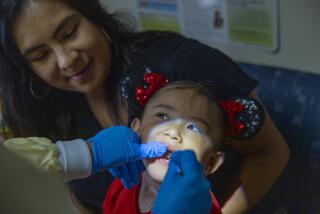Comforting news: Pacifiers have a plus side
- Share via
If calming a wailing infant wasn’t satisfying enough, pacifier-wielding parents can now quiet their critics as well.
Since ancient times, parents have been placing pacifiers in their babies’ mouths to comfort them, but some doctors, parenting experts and the occasional grandparent have suggested that pacifiers are substitutes for good parenting. Others have claimed that they are simply dangerous. Such criticism has made many parents “wean” their babies from pacifiers as quickly as possible -- or refrain from using them altogether.
Now researchers have found that pacifiers appear to reduce the risk of sudden infant death syndrome, better known as SIDS.
Several studies have found a 50% to 70% reduction in the risk of SIDS, and one recent report published in the American Journal of Epidemiology found that pacifiers reduce risk by as much as 90%. Experts estimate that one SIDS death could be prevented for every 2,733 infants who use a pacifier when placed for sleep.
No one completely understands why pacifiers seem to have this protective effect.
Some evidence suggests that infants who frequently use a pacifier are more readily aroused from sleep -- and that this heightened alertness may protect them from life-threatening challenges. Children who die of SIDS may simply sleep through such problems as getting their nose and mouth covered by bedding.
Pacifiers also might enhance an infant’s ability to breathe through the mouth if the nasal airway becomes blocked and might reduce the likelihood of airway obstruction by changing the position of the tongue.
In November, the American Academy of Pediatrics recommended that all parents consider offering a pacifier to their infants at nap time and bedtime throughout their first year.
This is the first time the academy has taken a position on pacifiers. Until recently, many experts have been reluctant to recommend them. Some major health groups including the World Health Organization have actually discouraged their use. Even the American Academy of Pediatrics is cautious.
“We don’t say be sure to use a pacifier,” says John Kattwinkel, chairman of the group’s Task Force on SIDS. “We simply say consider it.”
One of the biggest concerns about pacifiers has been the possibility that they interfere with breastfeeding. There is some evidence to suggest that when pacifiers are introduced at a very early age, they may shorten the length of time that infants breastfeed and result in early weaning.
Ear infections pose another potential problem. Pacifiers appear to facilitate the transfer of bacteria from the nose and throat to the middle ear, and babies who use them are at significantly higher risk for this type of infection.
Finally, there are dental problems to consider. The development of the mouth and teeth are influenced by the positioning of the tongue as well as the muscular movements of the cheeks and lips. Sucking on pacifiers alters these influences, and certain problems such as overbite are more common among children who use pacifiers than those who don’t.
Nevertheless, the academy believes that the potential benefits of pacifiers on SIDS outweighs these possible concerns. To minimize the likelihood of problems, the academy has developed some general guidelines for their use.
For infants who are breastfed, postpone introducing the pacifier.
“If you don’t use a pacifier until breastfeeding is well established, there’s no evidence to suggest that it’s a problem,” Kattwinkel says.
Pacifiers should not be used beyond a baby’s first birthday. The risk of ear infections begins to climb after 12 months of age, and the likelihood of SIDS drops significantly around this time.
Taking away pacifiers at this age has the added benefit of protecting against dental problems. Many of the dental changes caused by pacifiers disappear after their use is stopped. According to the American Academy of Pediatric Dentistry, pacifiers are unlikely to cause long-term problems if stopped by the age of 3 years.
For parents who hesitate to give their children pacifiers because they fear that the habit will be hard to break, there’s good news. Giving up pacifiers is typically easier than stopping a child from sucking their fingers, a habit that many infants who are not offered a pacifier pick up.
*
(BEGIN TEXT OF INFOBOX)
How to choose
* Opt for a one-piece model that has a soft nipple and a shield made of firm plastic. The shield must have air holes and should be at least 1 1/4 inches across so that the entire pacifier won’t fit into the baby’s mouth.
* Make certain the pacifier is the right size for your baby. Pacifiers come in two sizes, one for infants from birth to 6 months and another for children older than 6 months.
* There is no “right” shape. Select the shape that your baby prefers.
* Clean pacifiers regularly. Until the baby is 6 months old, pacifiers should either be boiled or run through the dishwasher frequently. After that, you can simply wash them with soap and water.
* Immediately replace pacifiers that show signs of wear.
* To prevent strangulation, never tie a pacifier around your baby’s neck, hand or crib.
* Do not use makeshift pacifiers (e.g. the nipple from a baby bottle) because they can create choking hazards.




